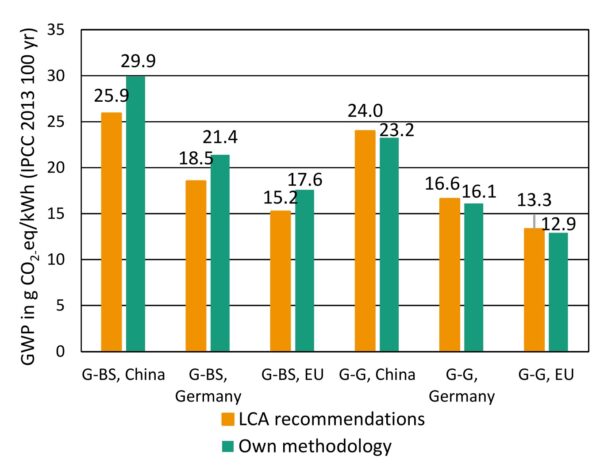An analysis by the International Energy Agency puts solar’s lifetime emissions, manufacturing included, at a level that would earn only 25% to 33.4% of the IRA’s $3/kg hydrogen incentive
Many assume that solar is clean enough to get any incentive. However, when we look at solar used in the production of hydrogen, it may prevent the hydrogen from qualifying for the hydrogen incentive in the Inflation Reduction Act (IRA).
A recent analysis by the International Energy Agency (IEA) suggests that most silicon-based solar photovoltaics, which is what is generally used in clean hydrogen production, may not qualify for the IRA’s $3 per kilogram incentive for clean hydrogen production. This is due to the fact that the manufacturing emissions for most crystalline silicon solar modules might potentially exceed the 0.45 kilograms of CO2e (carbon dioxide equivalent) per kilogram of hydrogen produced, which is the limit for the highest value IRA hydrogen incentive. In this context, CO2e refers to the lifetime emissions generated during the manufacturing process of solar panels, accounting for all greenhouse gasses in terms of their global warming potential.
According to HydrogenInsight, the IEA said that without further guidance from the IRS on the hydrogen incentive, it was premature to definitively state whether solar-derived hydrogen would or would not qualify.
The IEA analysis, “Towards hydrogen definitions based on their emissions intensity,” examined various energy sources and determined that only nuclear, onshore wind, some solar, and resources that capture emissions would qualify for the full $3/kg incentive.
Source: IEA
The rationale for this conclusion is based on the IRA’s definition of clean hydrogen in ‘Section 45V – Credit for Production of Clean Hydrogen’, which defines the base incentive of $0.60/kg of clean hydrogen. This price increases to $3/kg if the installation meets prevailing wage standards.
The IRA then categorizes ‘clean’ hydrogen incentives into four groups based on the estimated carbon dioxide (CO2) emissions of each kilogram of hydrogen produced, each receiving a percentage of the $0.60/kg:
- 20% – Less than or equal to 4 kilograms of CO2e/kg and greater than 2.5 kilograms of CO2e/kg
- 25% – Less than or equal to 2.5 kilograms of CO2e/kg and greater than 1.5 kilograms of CO2e/kg
- 33.4% – Less than or equal to 1.5 kilograms of CO2e/kg and equal to and greater than 0.45 kilograms of CO2e/kg
- 100% – Less than 0.45 kilograms of CO2e/kg
The IEA examines hydrogen production via solar-driven electrolysis driven by solar electricity to determine emissions. A cutting-edge electrolyzing technology that has not yet been released aspires to consume 40.4 kWh of energy for each kilogram of hydrogen produced. The Department of Energy suggests a value between 44 and 51 kWh/kg for hydrogen produced in an electrolyzer.
The IEA states:
Based on lifecycle analysis, the production of solar PV modules, for example, is currently associated with emissions of 18-50 g CO2-eq/kWh, which would result in an emissions intensity of hydrogen production of 0.9-2.5 kg CO2-eq/kg.
Using this calculation, solar-powered hydrogen would receive 25 or 33.4% of the $0.60/kg incentive. Solar modules would need to have approximately 9 g CO2e/kWh to reach the 0.45 kg CO2e/kg value required to qualify for the full $3/kg incentive.

Source: Fraunhofer
An analysis by Fraunhofer, A Comparative Life Cycle Assessment of Silicon PV Modules: Impact of Module Design, Manufacturing Location and Inventory, found the range of embodied emissions to be at the lower end of the IEA’s estimations. The study examined the country of origin’s power grid emissions, and the materials used in manufacturing to differentiate between solar modules. Glass-glass solar modules generally exhibited lower lifetime emissions, primarily due to their extended lifetimes, despite the resource-intensive nature of glass manufacturing.
Research published with support from First Solar shows that the company’s Series 6 solar modules emit 16.6 g CO2e/kWh.
Since solar power plant embodied emissions are primarily concentrated in the manufacturing of solar panel’s polysilicon, it is logical for this analysis to focus on the solar panel. However, to accurately determine the emissions per kilogram of hydrogen produced, it is also necessary to consider the capacity factor of the deployed solar power plant. This value is significant because it can vary considerably, with rooftop solar installations operating at capacity factors in the low teens, while single-axis tracker facilities in desert regions may approach 30%. This means that the same solar panel, when deployed in different regions, could generate nearly three times as much electricity.



